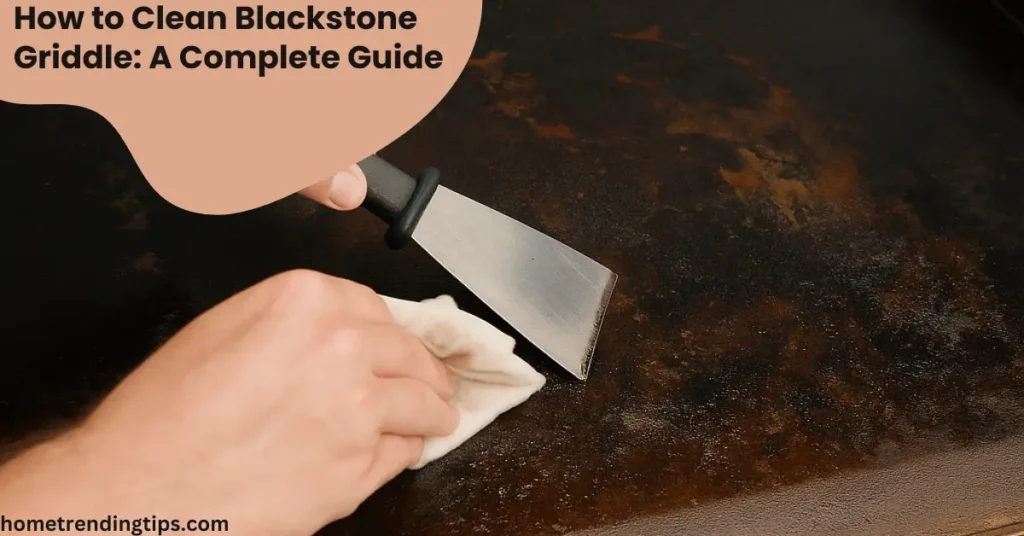If you’re a proud owner of a Blackstone griddle—or thinking about getting one—knowing how to clean and maintain it is essential for long-term performance and food quality. In this detailed guide, we’ll walk you through everything you need to know about how to clean Blackstone griddle the right way. From daily maintenance after cooking to restoring a rusted surface and properly seasoning your griddle, this article covers step-by-step instructions, best practices, and expert tips to keep your griddle in top condition for years to come.
Why Proper Griddle Cleaning Matters
If you’re wondering how to clean your Blackstone griddle, you’re not alone. These outdoor cooking powerhouses are beloved for their versatility—but to keep yours in top shape, regular maintenance is key. Cleaning your Blackstone properly not only preserves its non-stick surface but also prevents rust, food contamination, and performance issues. Whether you’re a weekend griller or a daily Blackstone chef, mastering this routine will extend the life of your griddle.
How to Clean a Blackstone Griddle After Cooking
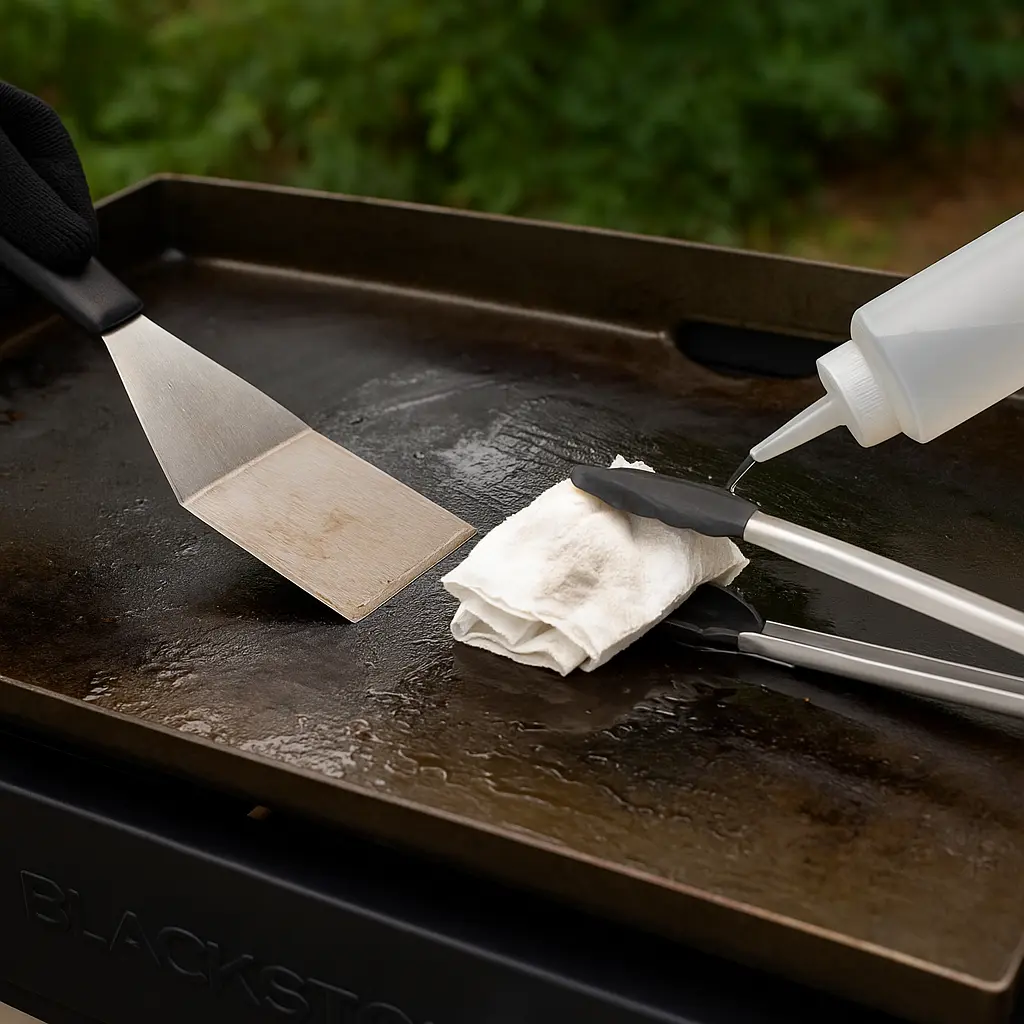
Cleaning your Blackstone after every use is simple, especially if you maintain it well-seasoned.
Step 1: Let It Cool Slightly
Once you’re done cooking, allow the griddle to cool down just enough so it’s safe to handle but still warm. This helps loosen food debris, making it easier to scrape off.
Step 2: Scrape the Surface
Using a metal spatula or heavy-duty scraper, gently remove all food bits and grease. Scrape toward the drip tray to keep the mess contained.
Step 3: Steam-Clean for Stubborn Residue
For stuck-on grime, pour a bit of water onto the hot surface. The steam helps lift residue. Use your scraper again to push the loosened gunk off the griddle.
Step 4: Dry the Surface Thoroughly
Once clean, turn off the griddle. Use heavy-duty paper towels or a cloth to dry the surface completely. This step is crucial to prevent rust.
Step 5: Apply a Thin Layer of Oil
Rub a thin coat of oil or griddle conditioner across the entire surface while it’s still warm. This protects the griddle and maintains its non-stick layer. Popular oil choices include canola oil, flaxseed oil, olive oil, or even bacon grease.
How to Clean a Blackstone Griddle After Winter or Heavy Use
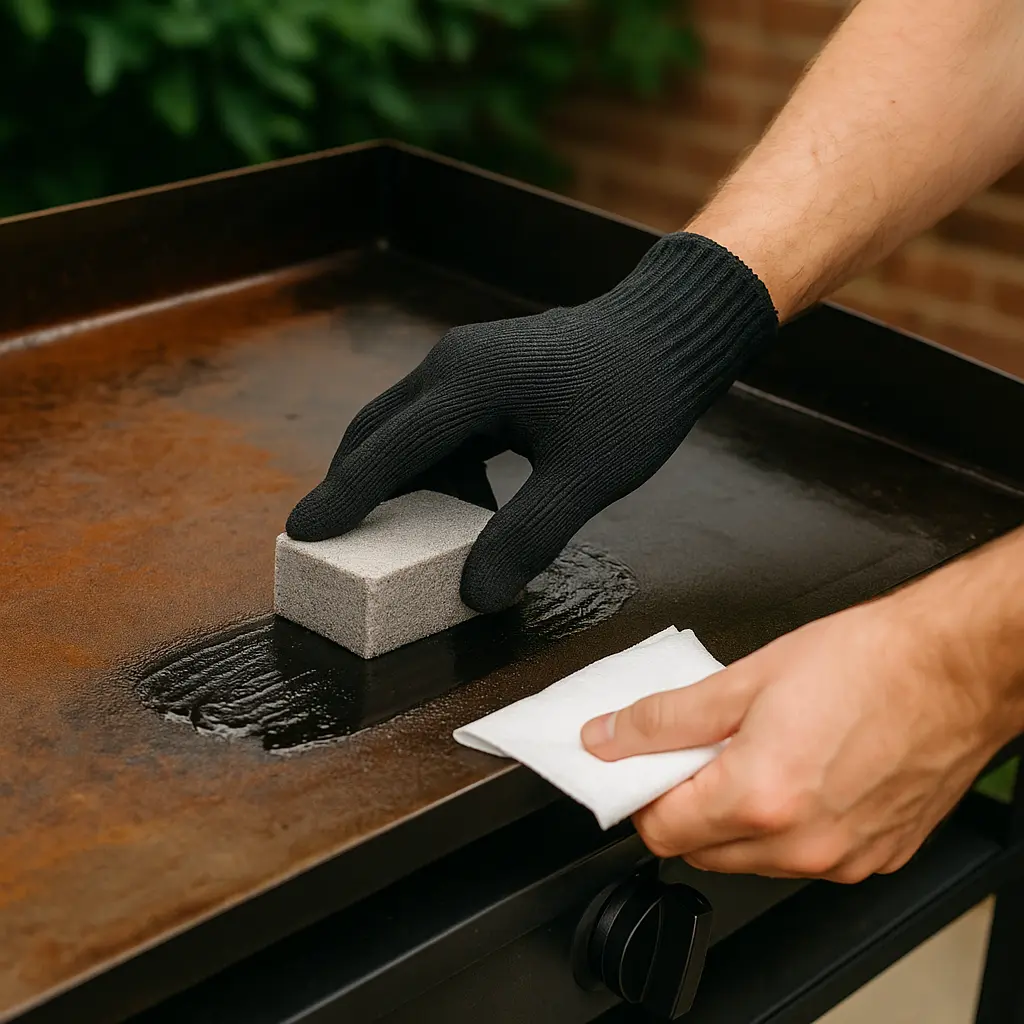
If your griddle hasn’t been used in months or shows signs of rust, it needs a deeper clean.
Step 1: Heat and Scrape
Turn the burners to high heat. Once hot, wear heat-resistant gloves and scrape away any rust or residue.
Step 2: Scrub With Oil and Grill Stone
Apply a few tablespoons of oil and scrub the surface with a grill pumice stone. This removes rust more effectively than wire brushes, which may damage the surface.
Step 3: Wipe and Repeat
Wipe the surface clean with paper towels. Repeat the oil and scrub process if rust persists. Finish by seasoning your griddle again to restore its non-stick layer.
How to Clean a Brand-New Blackstone Griddle
When you unbox your griddle, it needs a quick clean before seasoning.
Step 1: Mix Hot Water and Grease-Cutting Dish Soap
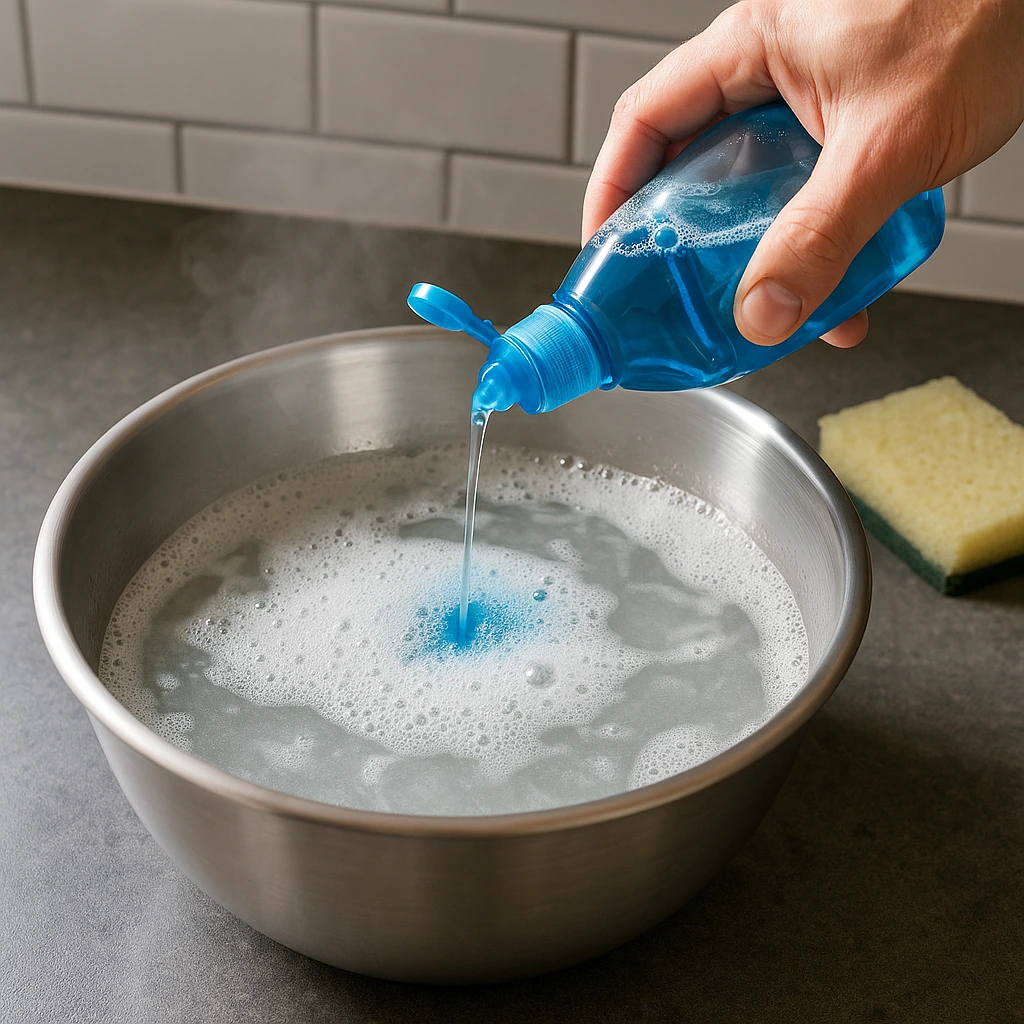
Begin by preparing a simple cleaning solution. Fill a bucket or bowl with hot water and add a few drops of grease-cutting dish soap. This combination is effective at removing the oils, protective coatings, and residue left behind from the manufacturing and shipping process.
Step 2: Scrub the Entire Surface Thoroughly
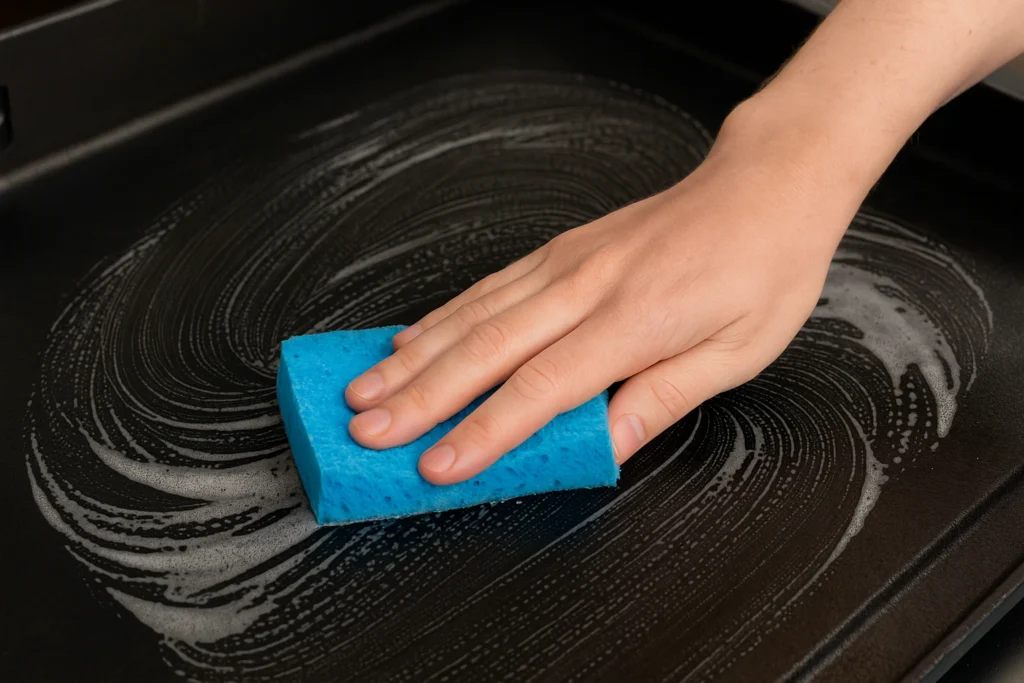
Dip a soft towel, sponge, or non-abrasive scrub pad into the soapy water. Gently but thoroughly scrub every inch of the griddle’s surface, including the corners and sides. This step helps break down and lift any contaminants, ensuring the cooking surface is clean and ready for seasoning.
Step 3: Rinse the Surface with Clean Water
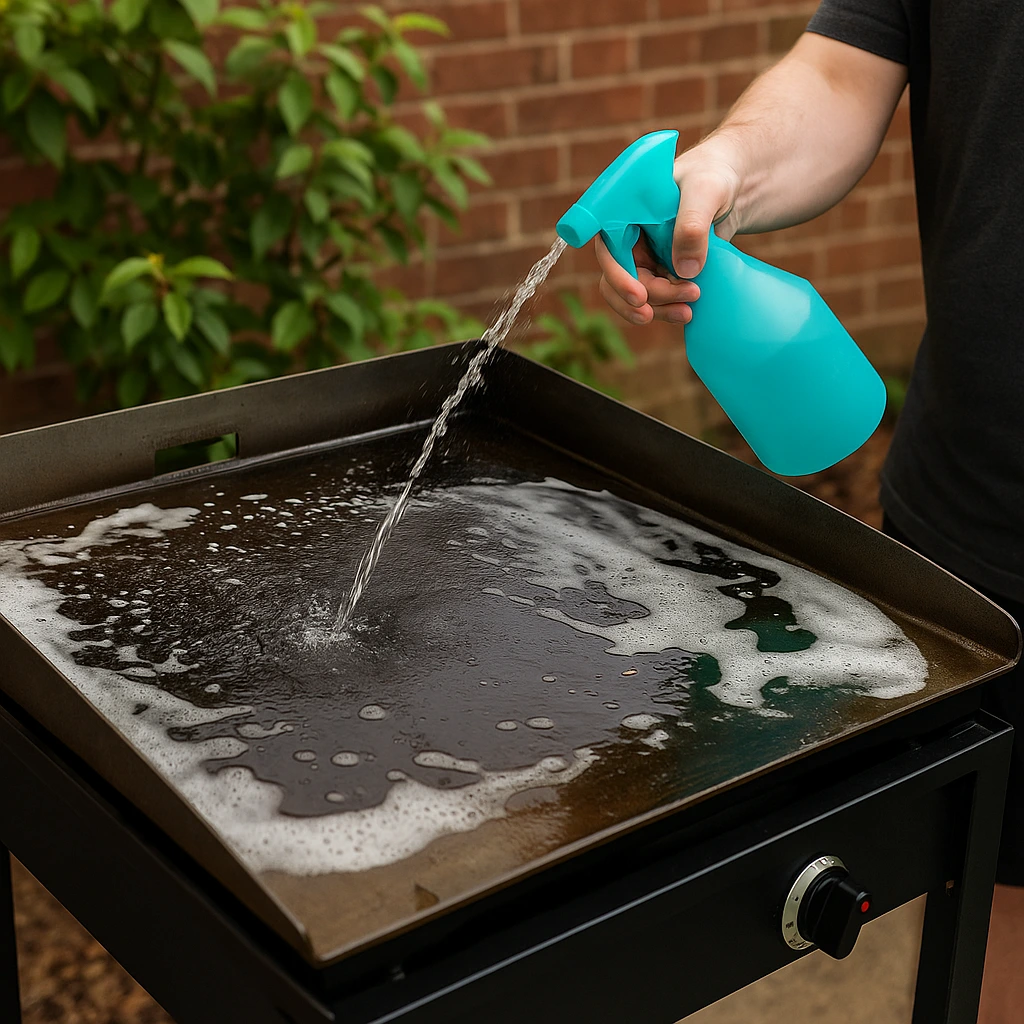
Once scrubbing is complete, rinse the griddle surface with clean water to remove all traces of soap. It’s crucial to eliminate any soap residue, as it can interfere with the seasoning process and affect the flavor of your food later on.
Step 4: Dry the Griddle with Paper Towels
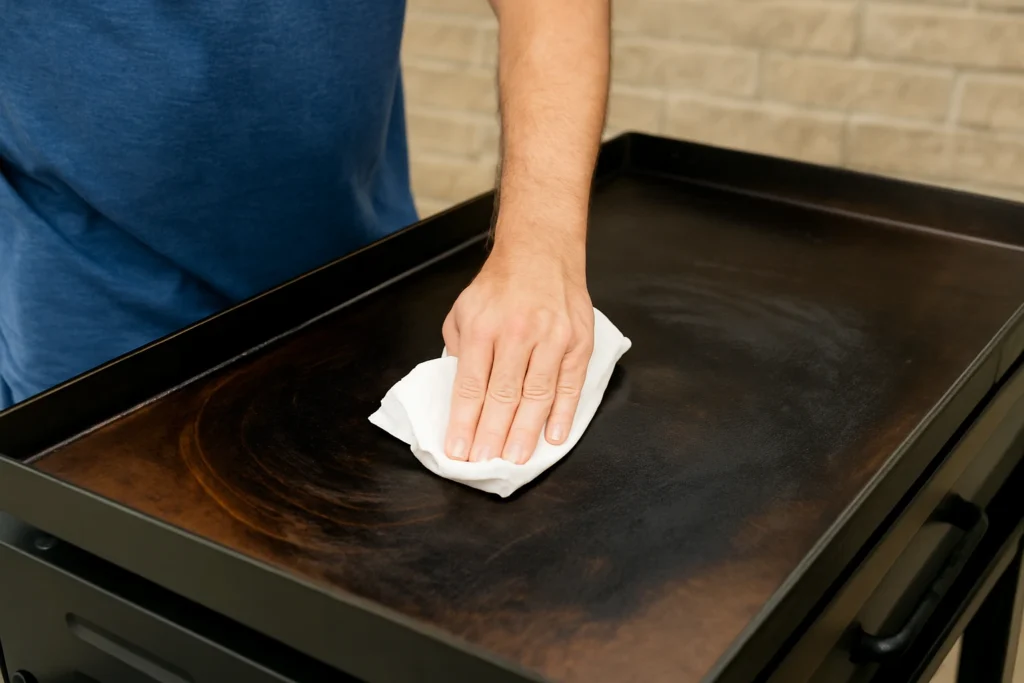
Use clean, absorbent paper towels or a dry cloth to completely dry the griddle surface. Removing all moisture prevents potential rust and prepares the surface for the next step. Be sure to wipe down all wet areas, including the corners and edges.
Step 5: Begin the Seasoning Process
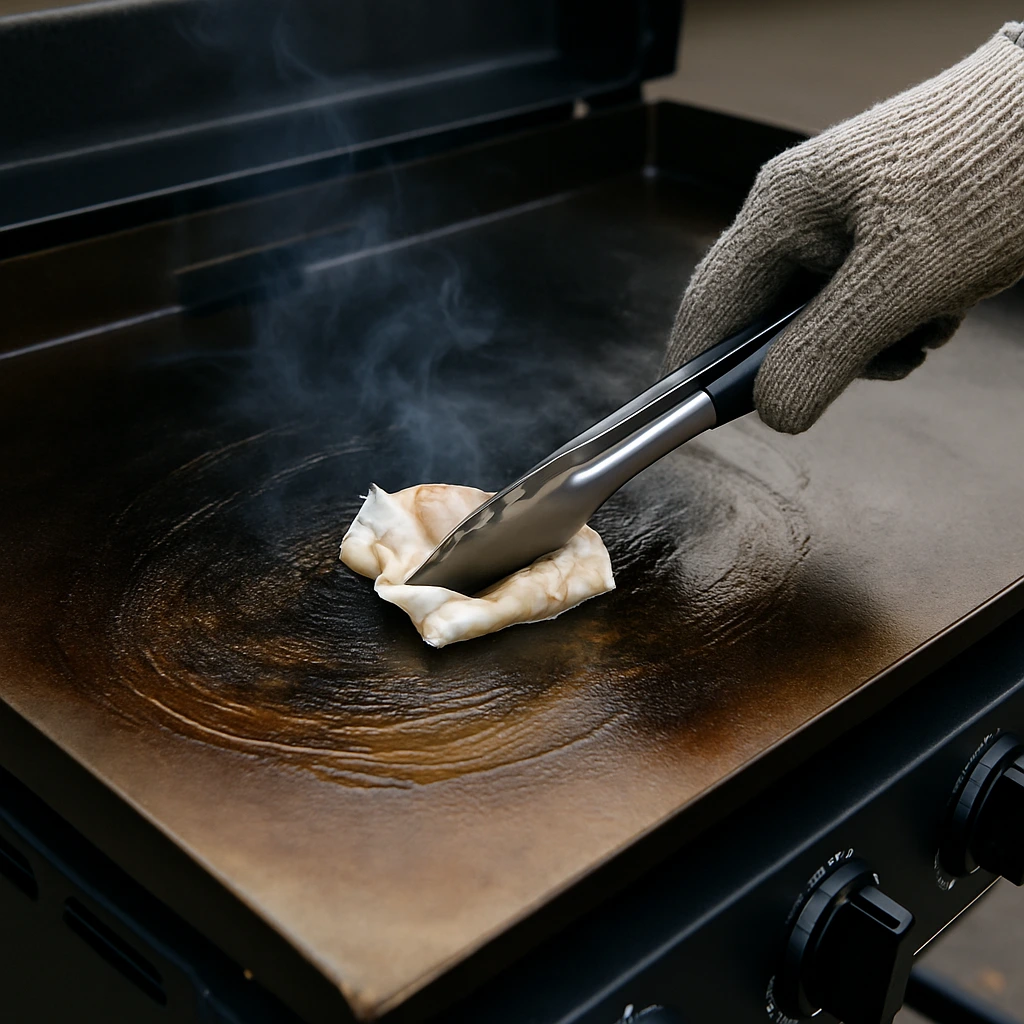
Now that your Blackstone griddle is clean and dry, it’s time to move on to seasoning. Seasoning creates a protective, non-stick coating that enhances performance and prevents rust. This is a crucial step in preparing your griddle for long-term use.
Note: This is the only time you should use soap on your Blackstone. After cooking begins, soap can degrade the seasoning and affect food flavor.
How to Properly Season Your Griddle
Seasoning is what creates that signature non-stick cooking surface. Here’s how to do it right:
- Turn all burners to high and let the surface heat up for 10–15 minutes.
- Apply 2–3 tablespoons of oil and use paper towels to rub it evenly across the surface (sides included).
- Let it smoke. When the smoke stops, repeat the oiling and heating process 2–3 more times.
- Once finished, let the griddle cool slightly and apply a final thin coat of oil before storing.
A seasoned griddle should appear dark and slightly glossy. This coating improves with every use.
Storing Your Blackstone Griddle
Proper storage is essential to keep your griddle rust-free and functional for years.
- Cool, Dry Environment: Keep your griddle in a shed, garage, or closet—anywhere free from humidity.
- Protect With a Cover: A heavy-duty canvas cover shields it from dust, scratches, and weather elements.
- Avoid Stacking Items: Never place objects on the cooktop surface, which could scratch or warp it.
Extra Tips to Make Your Griddle Last
Your Blackstone griddle is more than just a cooking surface—it’s an investment in flavorful meals and outdoor memories. With proper care, it can serve you for many years, developing an even better non-stick surface and richer flavor with every use. In addition to regular cleaning and storage, these expert-backed tips will help you protect your griddle from wear and tear, rust, and loss of performance.
Skip the Soap After First Use
After the initial soapy wash for your brand-new griddle, ditch the dish soap. Regular use of soap can strip the seasoning. Instead, clean with hot water, a scraper, and heat to maintain your non-stick surface.
Avoid Harsh Scrubbers
Skip steel wool or abrasive brushes—they can damage your griddle’s seasoning. Stick to non-abrasive pads or a grill stone for tough spots, and only use abrasives when removing rust, followed by re-seasoning.
Preheat Before Cooking
Always preheat your griddle to ensure even cooking and preserve the seasoning. A preheated surface helps oil bond properly, improving non-stick performance and food flavor.
Oil After Each Use
After cleaning, apply a thin layer of neutral oil while the surface is still warm. This keeps your griddle seasoned, prevents rust, and ensures it’s ready for next time.
Supervise While Hot
Keep kids and flammables away after cooking. The surface stays hot even after turning off the heat and can pose burn or fire risks.
Bonus Tip: Cook Often!
The more you use your Blackstone, the better it gets. Each cook builds up the seasoning, improving performance and durability over time.
FAQs
How often should I clean my Blackstone griddle?
After every use. A quick clean immediately after cooking helps maintain the surface and seasoning.
What oil is best for seasoning a Blackstone griddle?
Neutral oils like canola, flaxseed, vegetable, and olive oil are great. Bacon grease is also popular for added flavor.
Can I use soap on my Blackstone griddle?
Only when it’s brand-new. After the first wash, avoid using soap as it can damage the seasoning.
How do I remove rust from my Blackstone griddle?
Heat the surface, scrape off rust, apply oil, and scrub with a grill stone. Repeat until clean, then re-season.
Is it necessary to season the griddle every time?
Yes, applying a light oil coat after every clean preserves the non-stick surface and prevents rust buildup.
Final Thoughts
Knowing how to clean Blackstone griddle properly ensures it stays in excellent condition for years. With just a few simple steps—scraping, steaming, drying, and oiling—you can keep your cooktop performing like new. Whether you’re cleaning it after a big cookout or recovering it from winter storage, consistency is key. Treat your Blackstone well, and it’ll reward you with flawless, flavorful meals every time.
Disclaimer
Content on Home Trending Tips is for informational purposes only. Please consult professionals before making home or garden decisions.

